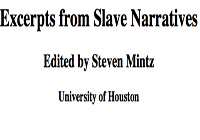Roosevelt Island
Greg Young and Tom Meyers describe the history of New York's Roosevelt Island, which once housed many of the city's prisons, mental institutions, and hospitals.
Greg Young and Tom Meyers describe the history of New York's Roosevelt Island, which once housed many of the city's prisons, mental institutions, and hospitals.

Unadorned and easy to navigate, this comprehensive website contains 46 first-person accounts of slavery and African life dating from 1682 to 1937. Each document is introduced with an illustrative sentence or short paragraph that describes the historical context.
There are both recognizable and unknown actors in this website. Former slaves such as Olaudah Equiano, Frederick Douglass, and Harriet Tubman, as well as white abolitionists such as John Brown express forceful, if familiar, condemnations of slavery.
In addition, there are unheralded historical voices that not only speak poignantly, but also reflect different (African-centered) perspectives. For example, a ship doctor's searing report of the Middle Passage; a slave husband's anguished letter to his wife after she was sold; and black social reformers' protests against the cruel punishments of slave owners.
When taken together, the assembled testimonies, including those by women, present slavery as a deeply entrenched institution that provoked a wide range of compelling commentary.
The Scarsdale Historical Society seeks to preserve and share the history of Scarsdale and the Central- and Mid-Westchester area, NY. The society operates two historic properties, the circa 1734 Cudner-Hyatt House and an 1828 Quaker meeting house. Topics addressed include daily life in the late 19th-century, the Civil War, and the Lenape people.
The society offers exhibits; two-hour curriculum-based educational programs with a lesson, tour of the Cudner-Hyatt House, activities, and a take-home project; one-hour educational programs; group tours; Scout activities; three themed traveling trunks with artifact replicas; and outreach presentations for schools. The exhibits and Cudner-Hyatt House are partially wheelchair accessible.
The museum collects, preserves, interprets, and displays historical and cultural materials related to the westward expansion, to Wyoming pioneers in particular, and to the west in general. Today, the 15,900-square-foot facility consists of the main building as well as the original cabin, two school houses, a rebuilt gristmill, and a shelter. The collections include pioneer and ranching memorabilia, textiles, and an extensive Native American artifact and decorative art display.
A second website for the museum can be found here.
The museum offers exhibits, research library access, and occasional recreational and educational events.
The Sica Hollow State Park is located in Lake City, South Dakota, and is the subject of many Indian legends. The Hollow is located in rolling hills created by glaciers over 20,000 years ago.
The park offers guided tours, the "Trail of Spirits" a self-guided nature trail, and interpretive guides who can help bring to life the legends of the Sioux Indians. The website offers visitor information and a brief history of the site.
In 1804 the Lewis and Clark expedition was told of Native American Spirit Mound and the spirits that dwelled there. Intrigued, the captains explored the mound and were captured by the view of the prairie.
Today teachers can bring their students to the park free of charge and hike up to the Mound (.75 mi.). Teachers must create their own tours as well as pre- and post-visit activities.
This iCue Mini-Documentary describes the war that ignited between England and France when a young George Washington was drawn into a skirmish with French scouts. Control over the continent of America was at stake as the two world powers conducted a massive war in the colonies.
The Nevada State Museum presents Nevada history. Exhibit topics include the Carson City mint, geology, Native American life, and Columbian mammoths.
Collection highlights include a 19th-century coin press, mammoth fossils, slot machines by designer Charles August Fey, the USS Nevada silver service, and a 1902 Basque sheepherder's wagon. The museum includes the Marjorie Russell Clothing and Textile Research Center, which preserves more than 10,000 artifacts.
The museum offers exhibits, tours, 90-minute guided hands-on student tours, and unguided student tours. Areas of emphasis available for student tours are geology, Native American culture, Nevada history, and botany and zoology. Appointments are required for all tours. The textile research center offers programs on costume history, as well as research library access. Appointments are required for library access. The website offers 14 virtual exhibits.
The Lake Hopatcong Historical Museum presents the history of New Jersey's Lake Hopatcong. Topics include the Lenape, Morris Canal, Bertrand Island Amusement Park, and the lake's prime resort years between the 1880s and 1930s.
The museum offers exhibits and lectures.
The Nevada Historical Society museum collections house over 15,000 artifacts, including mining and ranching equipment, artwork, clothing, and items related to the state's gambling industry. The permanent exhibition on Nevada history illustrates the lives of the earliest inhabitants of the Great Basin, the desert stretches of the Immigrant Trail, the Comstock era, the effects of Nevada's liberal marriage and divorce laws, and the rise of the gambling industry. The Nevada Historical Society's library, photograph, and manuscript collections constitute the largest and most complete repository of materials related to the history of Nevada and the Great Basin. Materials available to the public include books, newspapers and periodicals, print files, maps, government documents, subject files, ephemera, manuscript collections, and over 500,000 photographs.
The museum offers exhibits, guided and selfguided tours, hands-on activities, inclassroom presentations on a variety of subjects, a documentary presentation and discussion series, screenings of movies which are set in Nevada, and a research library. The website offers virtual exhibits, children's activities, and a comprehensive PDF outlining available teacher resources.